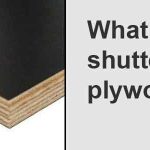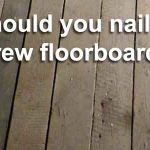Loose, damaged, and creaking floorboards are a common problem. When it comes to fixing them, you have several options that might be suitable. For example:
- Refit the existing floorboards – Often, loose boards can be screwed down to stop movement and creaking. Its very common for old nails to deteriorate and this can cause the boards to move and creak.
- Replace with new floorboards – For damaged boards that can’t be saved, you can replace with new floorboards. Or you could source reclaimed boards, that match the existing flooring.
- Chipboard flooring – This is another option; it tends to be cheaper than individual floorboards and is quicker to fit.
- Sheets of plywood – Another option, if you need to replace a large area of flooring is using Plywood. It is also common to overboard floorboards with thin plywood. This is often done, to create a flat surface for things like vinyl.

Plywood can be used to replace floorboards. It is less common, but when done correctly, it can provide a very strong and sturdy sub floor. The surface will also be very flat, making it ideal for tiling, laminate, vinyl, and other types of flooring, where a very flat surface is required.
Pros and cons of replacing floorboards with ply
As with anything, there are pros and cons to replacing floorboards with plywood. In this section, we we will be looking at some of the benefits and disadvantages you should be aware of, when replacing standard boards with sheets of plywood.
Pros
- Easy and quick installation – Because ply comes in large sheets (1220mm x 2440mm), it can be used to cover large areas with one piece. Essentially, the width of one board, is equivalent to twelve 100mm wide floorboards.
- Robust and sturdy – If you have joists spaced at 400mm centres, an 18mm plywood will be strong enough, without the risk of flexing. If joists are spaced wider, you can use 22mm or even 25mm.
Most standard floorboards are between 18 and 25mm anyway. So, if you are matching up to existing flooring, you can select the same thickness in plywood. - Cheaper than floorboards – In general, a good structural plywood will be around half the price of standard wood floorboards per square meter. This is obviously a rough guide, and prices will vary depending on where you buy.
- Flat surface – Due to the lack of joints, the surface can be very flat. Even on floors where some joists have twists and bellies. A large sheet of ply will smooth out any uneven areas in the floor joists. This can create a really nice flat surface. Ideal for other flooring such as laminates and even tiling.
Cons
- Need to support every edge – Plywood usually doesn’t have a tongue and groove. This means, you need to make sure every edge is fixed down securely. By securing the edges correctly, you will avoid the plywood lifting and creating steps in the joints.
To do this, you will need to install noggins where the edge of your plywood is not sat on a joist. This is obviously extra wok, and it will mean a small additional expense in timber for the noggins.
Once noggins are installed, and every edge of your board is sat on timber, you need to fix the board securely. Ideally you should use 50 – 60mm wood screws, fixed every 150mm. - Access below plywood – Replacing your floorboards with plywood is the easy part. However, at some point you may need to get below the flooring to access plumbing and electrics. Obviously, lifting a large sheet of ply is a much bigger job than lifting one or two floorboards.
One thing you can do to make this easier in the future, is mark the location of services on the plywood.You could also mark the joist centres. This would allow someone to safely cut a section out at a later date, rather than removing the whole board. - Boards will need cutting – The plywood sheets are very unlikely to fit without cutting. This means you will need tools to rip down the sheets. Cutting plywood with a handsaw will be hard work. Also, you will need a steady hand and a certain amount of skill to maintain nice straight cuts.
In this scenario, a much better option is a circular saw. You can buy a pretty good budget circular saw, for £40 – £50. You can see a Mac Allister circular saw review we did here.
Replacing small sections of floorboard with Plywood
In some cases, you may only be replacing the odd board here and there. In this situation there is very little (if any) downside to using plywood. Providing it is landing on a joist and is well supported, it should do the job perfectly.
As we mentioned previously, plywood comes in very similar thickness to standard floorboards, so it should fit quite seamlessly. If your plywood is slightly thinner, then a couple of well-placed packers, will easily bring it up to the correct level.
Conclusion
As you can see, replacing floorboards with plywood is an option. However, as with most things, it is a compromise. There are various pros and cons that we have mentioned above.
What you need to do, is weigh up the positive’s vs the negatives, and decide if this is a good option for you. Some of the main things to consider include, the price, how easy the job is, and access to services in the future. Basically, plywood flooring can be a decent replacement for standard floorboards. You just need to determine if it is the best option for your specific situation. In some cases standard floorboards or chipboard flooring might make more sense.




